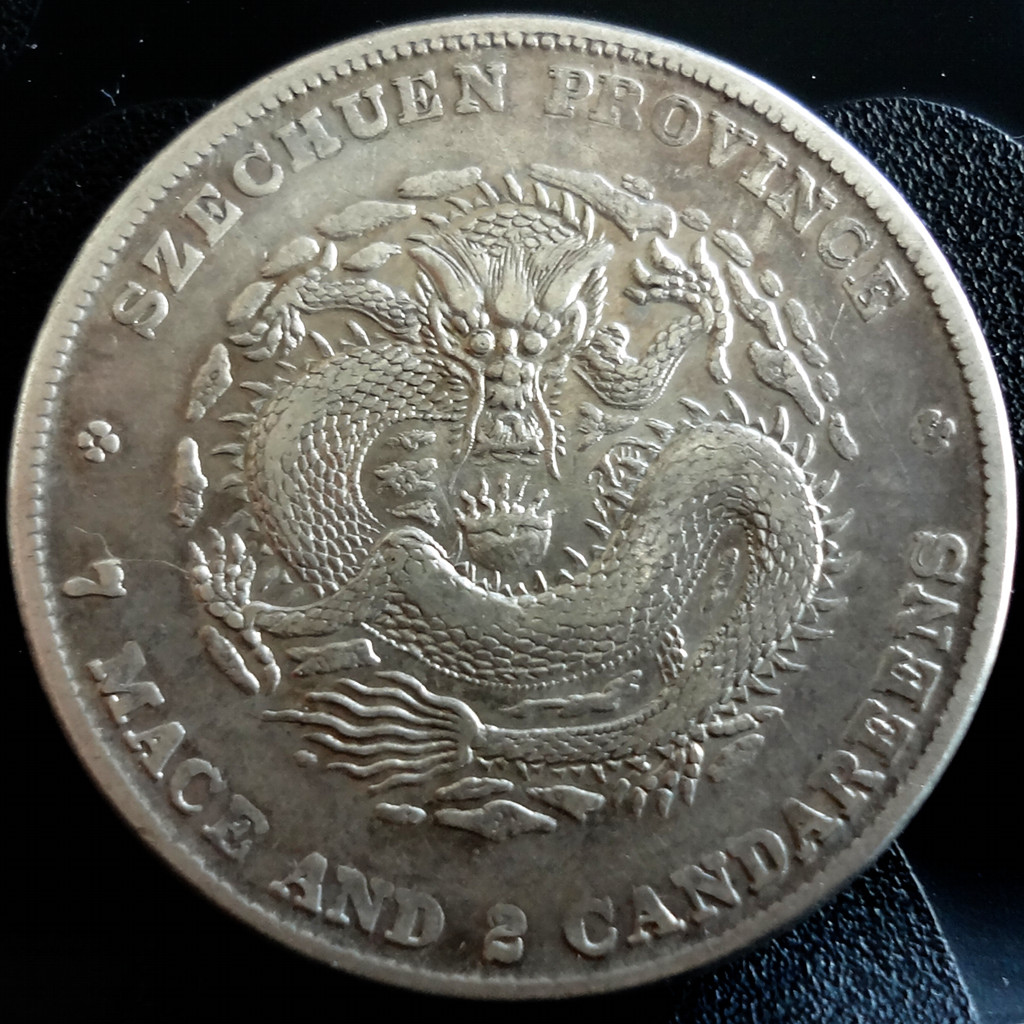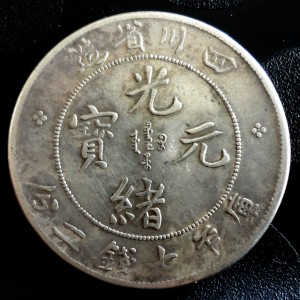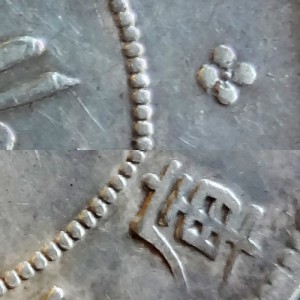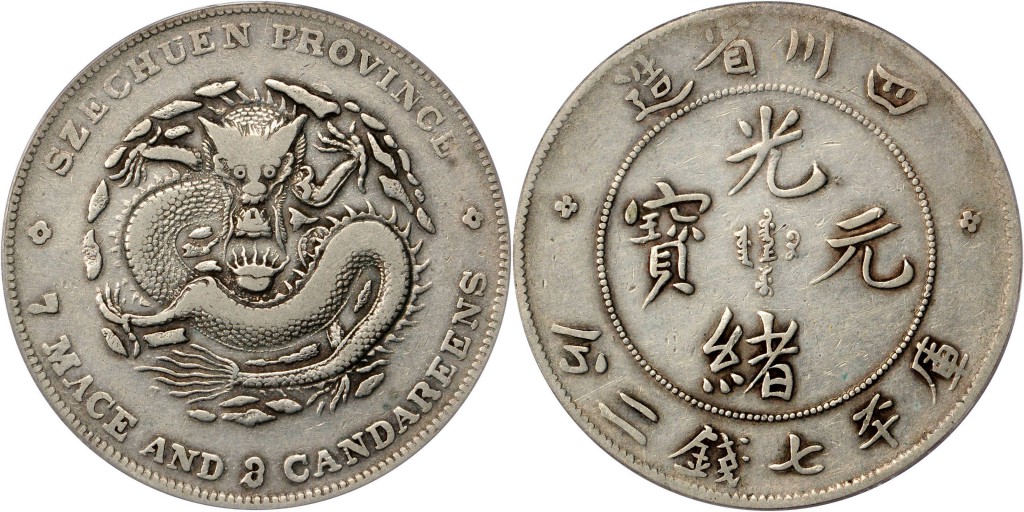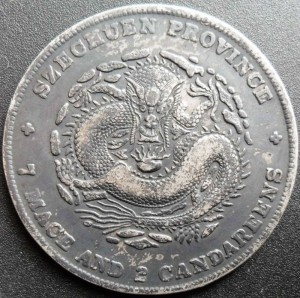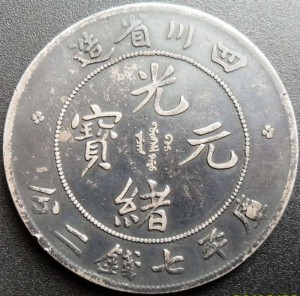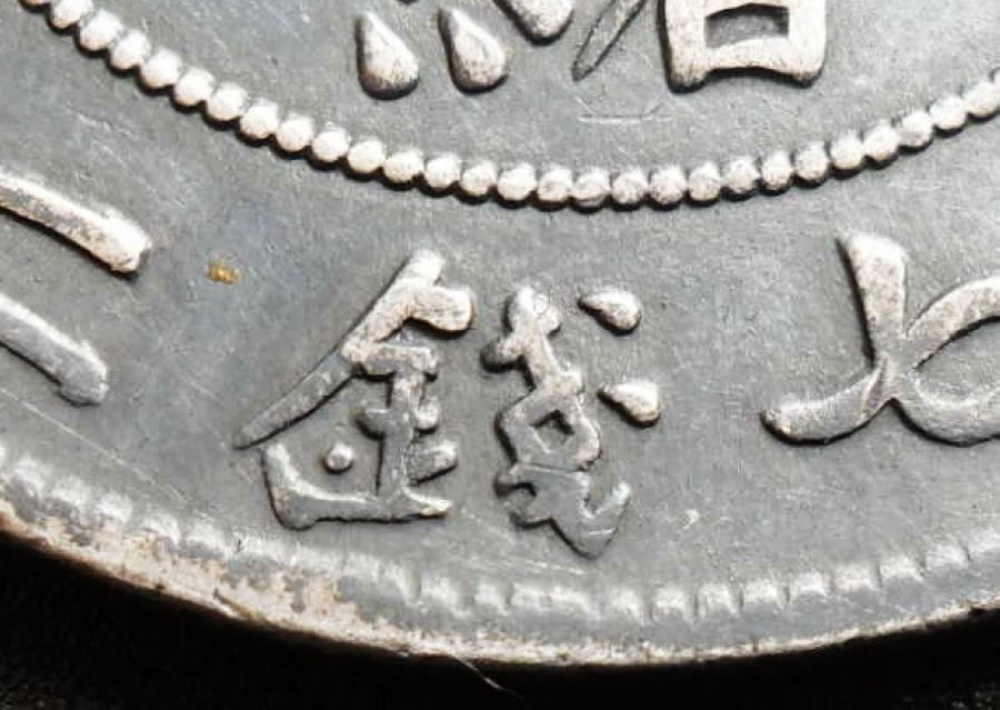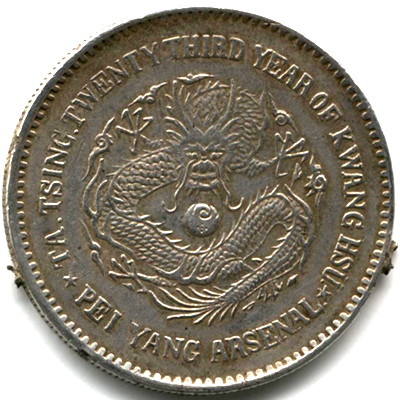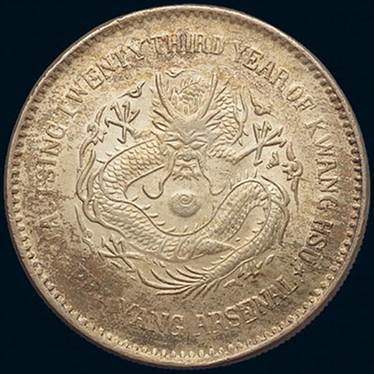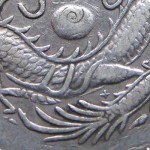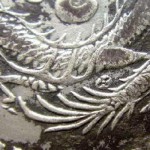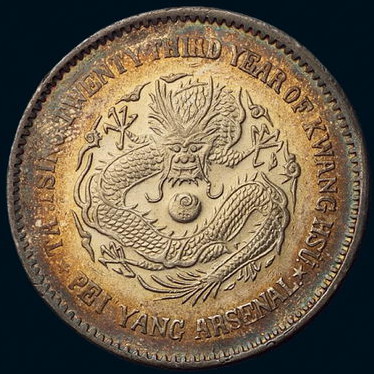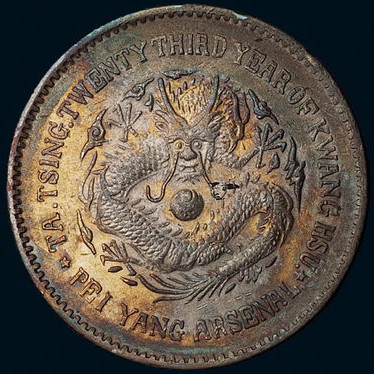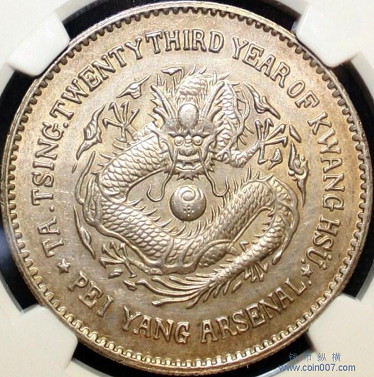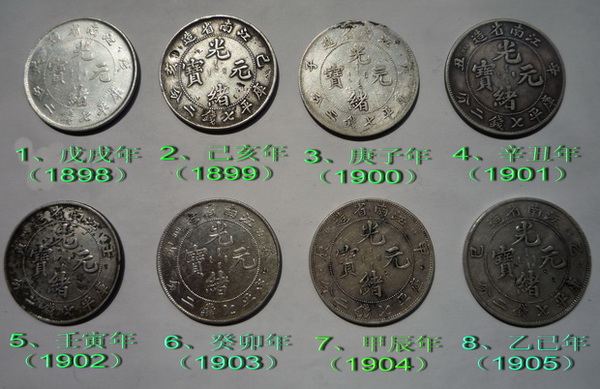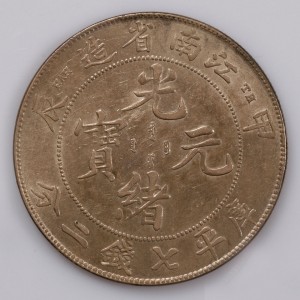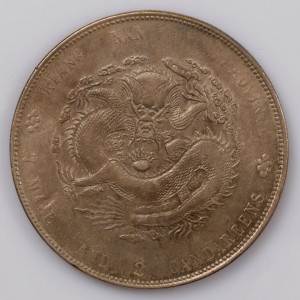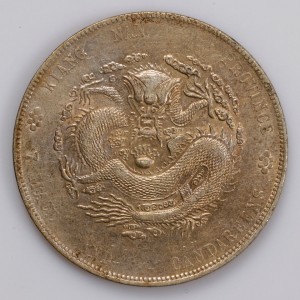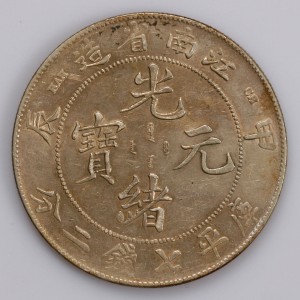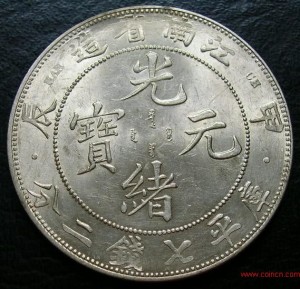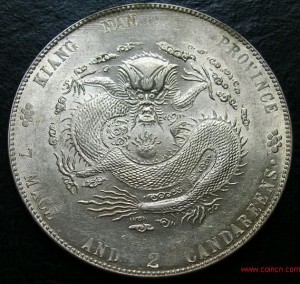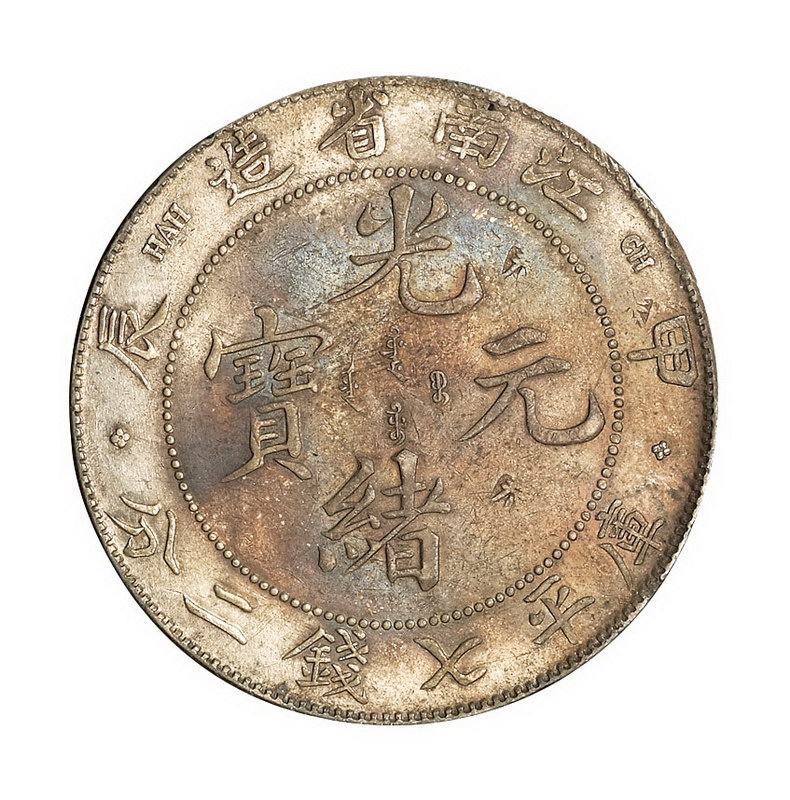Two weeks ago, I had the pleasure to travel back to the Szechuan province to pay an overdue visit to an old friend. Between enjoying the wonderful food in Nanchong and sipping tea by the Jialing river in Langzhong, I asked my friend to show me the antique market where the year before she had impulsively bought a lot of sixty fake coins. It was an excellent excuse for a stroll and I was curious to see if there would be anything genuine there. After walking through the crowded streets of the old Nanchong, we reached the market and went from shop to shop. There was indeed nothing of value, and I was ready to leave when a seller in a 旮旮旯旯 (pronounced kakagogo’r) corner of the market told me that he could show me interesting Chinese coins if I came back tomorrow.
Szechuan dollar Y-238 L&M 345 Doubled Die Obverse
The seller kept his word and indeed presented me genuine coins the next day. One of them caught my attention: it was one of the famous Szechuan three musketeers (四川三剑客). The Sān jiàn kè is a trio of rare and famous varieties of the Szechuan dollar, particularly coveted by Chinese coin collectors. These varieties are very difficult to find in good shape, some having been struck with badly duplicated dies, like the one I just found.
The coin I had in front of me was a 剑毛龙 (sharp spines dragon), with a misshapen 庫 character on the reverse: the top of the vertical stroke of 車, which normally should connect to the 广, was missing. The full name of this rare variety: “Sharp Spines Dragon, with a decapitated Chē and a rosette with dot” (剑毛龙无头车(花心带点)) sounds like a dish from a French restaurant menu but it is necessary to precisely identify this particular type amongst more than two hundred recensed varieties of the Szechuan dollar.
This variety is famous for the doubling of the English legend, especially on the word PROVINCE. The weak strike on the dragon scales and right eye are also normal for this particular type, most likely from trying to duplicate an already damaged die. If we had to draw a parallel with the Three Musketeers from Alexandre Dumas, this dragon burdened with a doubled die may be Aramis, struggling to reconcile the double life of an aspiring abbot become soldier…
The 7 Mace and 3 Candareens error Szechuan dollar
The coin I got in Nanchong is only second in rarity to the 7 mace and 3 candareens Szechuan dollar. That error coin is very hard to obtain in good condition, with most specimen available only in VF grade or less. The Chinese name of the variety is 尖角龙七三误书, or Pointed Horns Dragon with 7.3 lettering error. Despite its stated weight of 7 mace and 3 candareens in English on the obverse, the coin has a Chinese face value of 7 mace and 2 candareens, and a regular size and weight, contrary to the early Kwang-Tung dollar of same denomination that actually had a higher silver content. This rare error coin is affectuously called 三剑客老大 by Szechuan dollar collectors: the beloved elder of the Szechuan three Musketeers. I guess this rare and fierce dragon could be compared to Athos, the stern fatherly figure which is also the last to make its appearance in the book.
Szechuan dollar Y-243 L&M 352
The third musketeer is conversely the easiest to find of the trio. Called 大折金珍珠龙 in Chinese, or Pearl-scaled dragon with Crooked Gold, its particularity resides in the bold bottom stroke of the 金 part of the character 錢, which features an extravagant hook.
The Pearl-scaled dragon is one of the most beautiful varieties of the Szechuan dollar: most collectors will only seek it in higher grade, with all its scales still visible (全龙鳞), rejecting lesser condition coins (somewhat harshly called 垃圾龙, dragon-trash). Porthos, the elegant musketeer from Dumas’ epic, would likely have most fancied this last variety.
A reader from Germany contacted me recently about an enigmatic coin he bought on the flea market for 5 Euros. While not a coin collector, he loves curiosities and was profundly intrigued by this unusual Dragon Dollar…
… a beautiful Almond Eyed Dragon from the Peiyang Arsenal mint, one of the rarest variety of an already scarce type. It was obviously handled with great care; the dragon had kept all its scales, his fierce eyes still as piercing as a hundred years ago, when it first went out of the Peiyang Arsenal.
Without the mounting marks at 4 and 8 o’clock, this coin would be worth at least 4,000 Euros!
The design of the early Peiyang dragons is interesting as it is very strictly conforming to the traditional nine anatomical attributes of the Chinese Dragon:
- Deer horns
- Camel head
- Demon eyes
- Bull ears
- Snake neck
- Sea-serpent (蜃) belly
- Carp scales
- Eagle claws
- Tiger soles
Additionally, the Chinese dragon has a growth on his forehead, the Chĭ Mù (尺木), without which it is unable to ascend to the sky (龙无尺木,无以升天).
The depiction of the dragon on the coins issued in the 23rd year of Guāng Xù has been altered multiple times, with most changes related to the dragon’s eyes – probably due to the difficulty in finding a Demon to pose and capture its gaze…
The Evil-eyed Dragon (三角眼)
The dragon engraved on this first variety has evil, sightless “Triangle Eyes“, not unlike the 1896 test piece. It had most likely a high mintage, since it is only slightly scarcer than the most common variety for this year, the Beady Eyed Dragon, but it is hard to find in good condition nonetheless. Most of the surviving coins are worn out and damaged. There exists two additional variations of the “Evil Eyed Dragon”, both extremely rare:
The Almond-eyed Dragon (过渡眼三角眼)
This beautiful die variation can seem superficially very similar to the Evil Eyed Dragon, with only the addition of irides to the previously blind triangle eyes. However, by looking carefully, one can see clearly that this variety is not a mere modification of the original “Evil Eyed Dragon” but a whole revision of the initial pattern. The shape of the clouds surrounding the dragon is different, more intricate. The thigh of the dragon is now shorter. Five dots disposed in a cross pattern were also added to the pearl of wisdom. This type is only second in rarity to the mysterious Hidden Cross and Hidden Rose varieties.
The Beady-eyed Dragon (圆眼龙)
The Beady Eyed Dragon (which is the most common variant of the 1897 Peiyang dollar) has rounded eyes, contrary to the all the previous dies made that year. Like the Almond Eyed Dragon, it is a complete redesign, with the surrounding clouds and the shape of the eyes being modified. The change from a triangular to a rounded shape will persist in all the subsequent issues of the Peiyang mint.
The Dog-headed Dragon (狗头龙)
This very rare type is the last one minted in the 23rd year of Kwang Hsü. The dragon’s head has been completely redesigned, with short horns and a much bigger Chĭ Mù (尺木) on his forehead. The shape and style of the clouds has also been refined. This coin likely served as the prototype for the 24th year of Guāng Xù dollar, which keeps most of the new cloud details and the same Dragon face, although engraved in a crude fashion. The very striking difference in style makes me wonder if the Dog Headed Dragon dies could have been commissioned from another mint, but there is no conclusive evidence to support this theory.
All these dragon dollars are hard to find nowadays, due to the initial unpopularity of these coins: they were the first Chinese coinage denominated in Yuan (圆) and Jiao (角), while the whole country was still using the traditional monetary system based on weight. Their rejection caused most of them to be melted in order to mint new coins denominated in Mace and Candareens.
Congratulations to our German reader for making such a wonderful Snäppchen!
Kiangnan dollars were minted at the Nanking mint from 1897 to 1905. Early coins have a unique design and are quite scarce, but from 1899 on, the Nanking mint was one of the most prolific mint in China and the subsequent issues are common chinese coins. Some later years emissions have scarce variations or interesting varieties, though it may not be easy to immediately identify them for the casual collector, since the coins are all dated using the sexagenary cycle of the traditional chinese calendar.
A picture is worth a thousand words: the table below should make it very easy for anyone to identify the year of production of the various Kiangnan dollars.
Amongst them, the 1903 Gui Mao (癸卯) and the 1905 Yi Si (乙巳) coins are the scarcest and most valuable. In this article, I would like however to focus on the 1904 Jia Chen (甲辰) coin, which is more common but has an interesting history.
Starting from 1901, all the Kiangnan coins had some marks added next to the characters indicating the year. In the year of Xin Chou (辛丑), the initials of the British assayer H. A. Holmes, working for the Nanking mint, were apposed on the coins as a guarantee of their purity. Indeed, sloppy minting in the previous years raised concerns that people would start to distrust the coins and return to using the foreign currency circulating at the time. On the Gui Mao (癸卯) coins, a distinctive five pointed rosette was added as well.
In 1904 (Jia Chen (甲辰) year), two different marks were used in addition to the usual HAH initials: TH and CH.
According to the mint records, only one million coins with the TH mark were minted. It is generally supposed that “TH” are the initials of the die engraver, but his name has unfortunately been lost. Some have said that “TH” stood for the first two letters of the name of the auxiliary mint director (副厂长), Deng Ju (邓矩), but this seems unlikely. The Wade-Giles romanisation (in use at the time) of his name would be Teng Chü, not Theng.
While the meaning of the TH initials remains obscure, it is probable that CH does actually stand for the name of the new director of the mint, who took up his functions the same year. At the time, the direction of the mint changed frequently due to the fact it was a very lucrative – and thus, coveted – position. In April 1903, Shen Bang Xian (沈邦宪) was appointed director, then replaced in September of the same year by Pan Ru Jie (潘汝杰), himself succeeded in April 1904 by Zhang Qian Jie (张迁杰)… Zhang Qian Jie was in charge during the time the Jia Chen coin were minted, and the initials of his surname (romanised Chang at the time) match the CH mark.
If this is indeed the meaning of the CH mark, it becomes easier to put a timeline on the production of the different versions of this coin. The coins marked TH use the same design than the previous year, likely because the engraver didn’t had the time yet to complete the new dies. Some CH coins use the old dragon design too, but with a new reverse, as seen below.
Why the haste to engrave a new reverse and put it in production when the obverse wasn’t even completed? Well, it must have been tempting for the newly appointed director to seize the opportunity to immortalise his name on the new dies, knowing full well that his successor in six months would not be able to replace them before the next year… This scheme worked even better than he could have expected when the Jia Chen dies bearing his initials were reused from November 1911 to February 1912, after the fall of the last Emperor.
From this timeline, it is easier to determine which coins were minted during the Qing era and which coins are republican restrikes: coins bearing the TH marks, and early CH coins featuring the old dragon design, were both obviously made in 1904. For subsequent coins, things are somewhat less clear. Coins with the new dragon design and the CH initials have die differences too; and the most common of them is the addition of dots on the reverse.
As seen above, the new dragon design only differs subtly from its predecessor. The face of the dragon and the design of the flame to the left of the central fireball are the most distinctive differences; one can see that the weaker strike on the tail of the dragon (next to its right hindleg) has also been fixed.
The coin pictured above features another interesting difference: a dot has been added next to the denomination. This alteration was probably made on republican restrikes, like the variant of the 1911 imperial silver dollar (with a dot after “DOLLAR”) which was actually minted after the fall of the Manchu regime. Coins with dots on the reverse but without the dot after the denomination were thus quite possibly minted during the Qing era.
A scarcer variation exists, with rosettes instead of dots on the reverse. It is likely that this coin was minted in 1904 as well.
Of all these variations, the coins bearing the TH mark are the scarcest and the most expensive. The CH coins are all much less valuable, due to their relative abundance. This lead less than scrupulous coins dealers to scrub the C out of their common coin, and replace it with a T in an attempt to “upgrade” their coin and sell it for an higher price. Unfortunately for them, these initials is not the only difference between these coins. As we discussed before, some CH coins have the same dragon design than the TH coins, but not all. Even if the counterfeiter is careful and pick the right dragon pattern, the reverse of these coins has obvious differences for the connoisseur.
- The “legs” (3rd and 4th stroke) of the Yuan character, 元, are connected on a genuine TH
- The 甲 character points between the top and middle horizontal bars (1st and 2nd stroke) of the 元 character on a genuine TH coin
- The 甲 character points to the 2nd stroke of the 元 character on a CH coin
- the 辰 character is slightly “higher” (closer to HAH) on a genuine TH coin
As usual, always be careful and exerce your judgement when you buy an old chinese coin !
